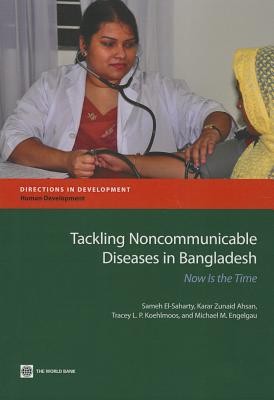
- We will send in 10–14 business days.
- Author: Sameh El-Saharty
- Publisher: World Bank Publications
- ISBN-10: 0821399209
- ISBN-13: 9780821399200
- Format: 17.8 x 25.4 x 0.8 cm, minkšti viršeliai
- Language: English
- SAVE -10% with code: EXTRA
Reviews
Description
Bangladesh is undergoing a double transition--demographic and epidemiological. Increasing life expectancy and declining fertility entail a demographic transition fueling a shift in the disease burden toward noncommunicable diseases (NCDs). Yet due to absence of a robust routine health information system in the country, it is hard to accurately assess the disease burden and corresponding risk factors. So, using a wide range of sources, this book looks at the status of major NCDs in Bangladesh (and briefly in South Asia), touches on their economic impact, analyzes their common risk factors, and assesses the health system's capacity to manage the disease transition. In a country where total health spending is low--$23 a head per year, two-thirds of it private--the main constraints on the health system are a weak regulatory framework; lack of strategic planning and coordination across sectors; lack of alignment between the goals of health strategy documents and the operational plans; a focus by the health system on treatment, not prevention; and a fragmented health service delivery system, leading to a lack of coordinated care critical for effectively managing NCDs. This book aims to help policy makers--inside and outside the Ministry of Health and Family Welfare, and its program managers--to develop and implement effective and timely responses that reduce both population-level risk factors and the NCD burden in Bangladesh. It also outlines policy options and strategic priorities to help stimulate policy dialogue with stakeholders to tackle the NCD burden through strengthening health service provision, all articulated through a "Policy Options Framework". This framework is founded on the stewardship and regulatory role led by the health sector (represented by the Ministry of Health and Family Welfare), which supports two broad categories--population-based and individual-based policy interventions, which in turn support four pillars: multisectoral and health sector interventions (population-based), and clinical preventive and treatment services (individual-based).
EXTRA 10 % discount with code: EXTRA
The promotion ends in 21d.16:10:58
The discount code is valid when purchasing from 10 €. Discounts do not stack.
- Author: Sameh El-Saharty
- Publisher: World Bank Publications
- ISBN-10: 0821399209
- ISBN-13: 9780821399200
- Format: 17.8 x 25.4 x 0.8 cm, minkšti viršeliai
- Language: English English
Bangladesh is undergoing a double transition--demographic and epidemiological. Increasing life expectancy and declining fertility entail a demographic transition fueling a shift in the disease burden toward noncommunicable diseases (NCDs). Yet due to absence of a robust routine health information system in the country, it is hard to accurately assess the disease burden and corresponding risk factors. So, using a wide range of sources, this book looks at the status of major NCDs in Bangladesh (and briefly in South Asia), touches on their economic impact, analyzes their common risk factors, and assesses the health system's capacity to manage the disease transition. In a country where total health spending is low--$23 a head per year, two-thirds of it private--the main constraints on the health system are a weak regulatory framework; lack of strategic planning and coordination across sectors; lack of alignment between the goals of health strategy documents and the operational plans; a focus by the health system on treatment, not prevention; and a fragmented health service delivery system, leading to a lack of coordinated care critical for effectively managing NCDs. This book aims to help policy makers--inside and outside the Ministry of Health and Family Welfare, and its program managers--to develop and implement effective and timely responses that reduce both population-level risk factors and the NCD burden in Bangladesh. It also outlines policy options and strategic priorities to help stimulate policy dialogue with stakeholders to tackle the NCD burden through strengthening health service provision, all articulated through a "Policy Options Framework". This framework is founded on the stewardship and regulatory role led by the health sector (represented by the Ministry of Health and Family Welfare), which supports two broad categories--population-based and individual-based policy interventions, which in turn support four pillars: multisectoral and health sector interventions (population-based), and clinical preventive and treatment services (individual-based).


Reviews